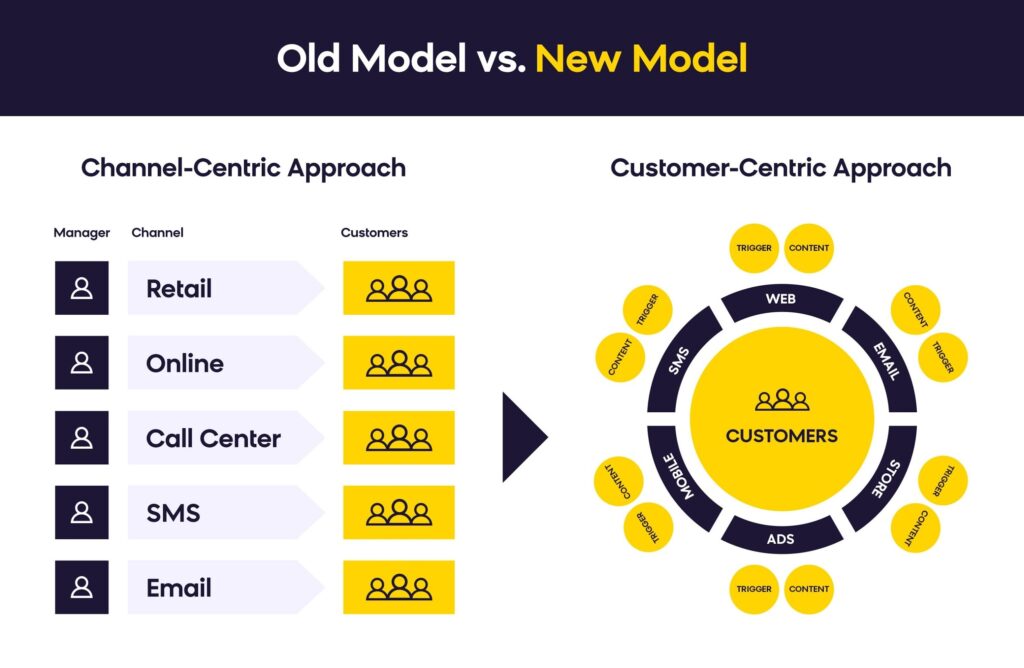How to implement and get the most out of your CDP
Contents
- How to implement and get the most out of your CDP
- Key Points of the Customer-Centric Approach
- Why Should My Company become Customer-Centric?
- Drive Your Decisions With New Insights
- Set New KPIs That Make Sense
- Customer Lifetime Value (CLV)
- Customer Equity
- Customer Lifecycle Distribution
- Ensure All Departments Buy in to your CDP
- CDP Pitch Guide to Various Departments
If you did the research and chose a great vendor for your new Customer Data Platform, congratulations! Now you can look forward to marketing segmentation, breaking down your data silos, and getting a much more complete picture of your customer.
But your job has only just begun. A CDP is a great investment, but it is not an automatic miracle–successful implementation with a customer-centric approach is key.
If you have the right mindset, lay the groundwork, and establish good processes, you can achieve success with your CDP.
Key Points of the Customer-Centric Approach
To get the most out of your CDP, you must become a customer-centric company. Of course this is easier said than done, as it may require a significant cultural shift. It may also take some time, but if you commit to a holistic, customer-focussed approach, you will reap the benefits. There are some key steps to take here, as well as an explanation of why this approach is so important.
Let’s break down the customer-centric approach to your CDP:
● Why is it important?
● Drive decisions with customer-centric data
● Set the right KPIs
● Get all departments on board
Why Should My Company become Customer-Centric?
Your CDP is already customer-centric. Companies, however, are often not. Marketing departments, for example, are often broken down into teams that each focus on a different channel: email, social media, direct mail, etc. If the data provided by these channels is siloed like this it can give the customer a bumpy ride.

But this is why you acquired a CDP in the first place, isn’t it? Now you can break down these data silos and give every member of your company a complete picture of your customer. To fully take advantage of everything your CDP offers, you need to transform your employees’ mindsets and make the customer-centric approach the new reality of doing business.
Drive Your Decisions With New Insights
A large part of the shift in mindset here relates to how you make your decisions. Moving forward, make your marketing and other decisions based on customer-centric data. Rely on your Customer Data Platform to give you rich analyses and insights, and shift your decision-making paradigm accordingly. Use your CDP’s insights to drive your actions.
Set New KPIs That Make Sense
Customer-centricity means customer loyalty, and loyalty is a metric you can measure. Your company needs a CEO, CMO, or other higher-up to set this as a priority and drive your efforts.
Here are three examples of KPIs that can help you guide your team:
Customer Lifetime Value (CLV)
Calculate the average CLV like this, for example:
CLV = Average order value x Purchase frequency x Gross margin x (1 / Churn)
Include purchase frequency and churn to get a good overall picture of your customer loyalty over time.
Customer Equity
A logical follow-up to CLV:
Customer equity = CLV x Number of customers acquired in a specified time frame
This metric gives you a look at both the value and quality of your customer base.
Customer Lifecycle Distribution
This gives you insight into your company’s customer loyalty. Monitor lifecycle segments closely for any wild swings in customer distribution; this likely indicates changes in the loyalty of your customer base.
Ensure All Departments Buy in to your CDP
When you think of how to implement your CDP, you may only consider your marketing team. But a CDP benefits other teams, too. Make sure each team has access to customer profiles, and understands the customer journey. Pitch your unified vision along with practical ways to get them on board.
CDP Pitch Guide to Various Departments
Marketing
Let’s start with the most obvious team. You probably won’t need to ‘pitch’ the CDP to this team, but if they need help understanding the platform or even a bit of persuasion, here are a few key ways a CDP will contribute to their efforts:
● Single customer view. You’ll understand your customers in a whole new way with unified customer profiles.
● Omni-channel marketing. Make use of your CDP’s omni-channel capabilities, or integrate your new CDP with the marketing platforms you already have in place.
● Data-driven decisions. Support your new goals and replace intuition with insights informed by hard data by utilizing the extensive analytics capabilities of your CDP.
Sales
It stands to reason that stronger, better-focused marketing will positively affect your sales. There are actually CDPs crafted specifically for sales teams. Most CDPs will help your sales team in these ways:
● Single customer view. Aggregating a customer’s information into a single unified profile can give meaningful context and insight to all sales team members.
● Lead scoring. A CDP can take all the data in a single customer profile and then rank that customer according to value. Data enrichment will give your sales team insight into which leads are the hottest. They can set up an automatic notification of these hot leads by integrating an internal messaging tool.
Customer Service
If your team uses a Customer Relationship Management tool, using a CDP should not be a stretch. CDPs often function similarly to CRMs, and can also supplement CRM software with valuable data:
● Improved customer satisfaction. A unified customer profile gives your team a complete, clear overview of the customer which can lead to more productive interactions and more enjoyable customer experiences.
● Automated customer care. If you acquire a CDP with built-in communication automation, you can send surveys, welcome emails, and other specific communication to customers at the right moment in their customer journey. For example, email automation can be set up to send a follow-up to customers who’ve made a recent purchase.
● Customer support ranking. CDPs can help rank your customers according to urgency, ensuring those most in need of attention will get it sooner.
IT
Your IT department should love your new CDP! A successfully implemented CDP will translate to fewer demands for IT assistance from your marketing team. The CDP will help:
● Separate your IT and marketing teams. Now marketing team members can access data directly from the CDP instead of relying on IT for information. (No more email marketing metrics reports, for example – they’ll have the info they need already!)
● Streamline integrations. The most common marketing tools and platforms are usually easily integrated into a CDP, so there’s no need for IT teams to spend time and energy setting these up.
● Improve efficiency. With your CDP up and running, you now have one central location for your customer data and business rules. Your IT department no longer has to duplicate information across multiple platforms. The single customer view comes in handy here.
BI – Business Intelligence
Business Intelligence teams should also be excited about what a CDP can do for them, as it will collect and analyze all kinds of customer data from multiple sources. Benefits for your BI team can include:
● Attribution modeling. Some CDPs can help determine your marketing efforts’ ROI with this tool.
● Segmentation and analysis. Insights into the customer journey and purchasing habits can provide clearer context for your BI team.
By ensuring that key members of various teams across your organization buy into the benefits a CDP can yield, you can shape your entire company’s vision to one of customer-centricity.
CDP + Customer-centric Approach = Customer Love
A CDP offers many ways to help you become more focussed on the customers’ needs. Monitor which offers you are making to whom, control your email deliverability rates, and keep an eye on who may be slipping away.
Make sure your customers feel like kings and queens and cement the all-important brand loyalty by implementing your CDP with a customer-centric approach. If they feel the love, so will you.


